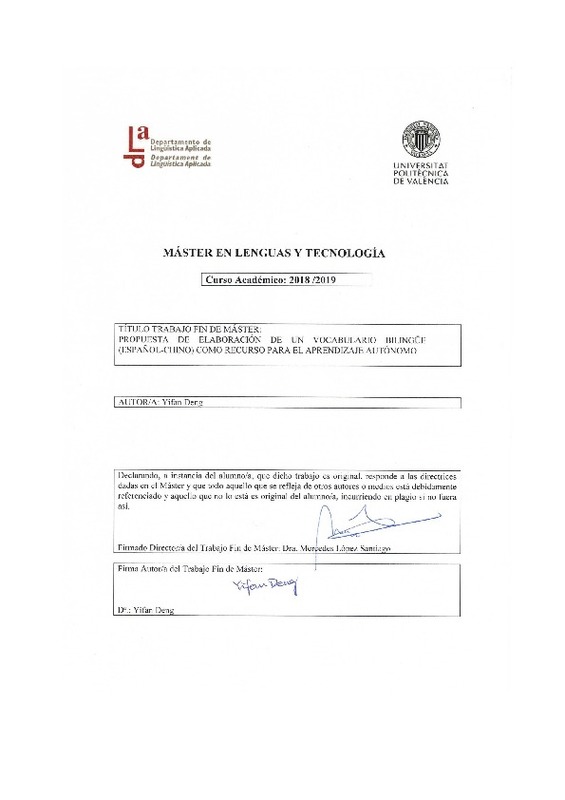|
Resumen:
|
[ES] La enseñanza del español lengua extranjera (ELE) en China, cuya andadura comenzó en 1952, supone un gran reto, tanto para los profesores como para los alumnos sinohablantes, debido a las grandes diferencias lingüísticas ...[+]
[ES] La enseñanza del español lengua extranjera (ELE) en China, cuya andadura comenzó en 1952, supone un gran reto, tanto para los profesores como para los alumnos sinohablantes, debido a las grandes diferencias lingüísticas (alfabeto, fonética, sistema verbal, etc.) y culturales que existen entre las dos lenguas.
El objetivo principal de este Trabajo Fin de Máster es la confección de un vocabulario bilingüe (español-chino) piloto como recurso para el aprendizaje autónomo del Español Lengua Extranjera (ELE) por parte de estudiantes sinohablantes. El diccionario permite a los estudiantes consultar dudas ortográficas y de significado, pero también les sirve de ayuda para redactar, de manera autónoma, textos de distintos tipos y según su nivel en ELE.
Con la elaboración de este vocabulario bilingüe pretendemos potenciar la participación e implicación en la confección de este vocabulario bilingüe de los estudiantes porque contiene palabras propuestas por ellos. A partir de ellas, hemos confeccionado fichas que incluyen: categoría gramatical, género, ejemplo de uso en contexto auténtico, fuente de este ejemplo, equivalente en chino y comentarios lingüísticos y culturales junto a una imagen ilustrativa del significado.
Este vocabulario bilingüe podrá ser completado por estudiantes sinohablantes según sus necesidades y a lo largo de su aprendizaje del español. De este modo, se lograra que su participación sea más activa en su proceso de aprendizaje autónomo de esta lengua.
Finalmente, esperamos que este trabajo contribuya a la enseñanza y aprendizaje de ELE para estudiantes sinohablantes y, que sirva, especialmente, para aquellos que quieran aprender por ellos mismos, es decir, de manera autónoma.
[-]
[EN] The teaching of Spanish as a foreign language in China, which began in 1952, is a great challenge for both teachers and Chinese students due to the great linguistic differences (alphabet, phonetics, verbal system, ...[+]
[EN] The teaching of Spanish as a foreign language in China, which began in 1952, is a great challenge for both teachers and Chinese students due to the great linguistic differences (alphabet, phonetics, verbal system, etc.) and cultural differences that exist between the two languages.
The main objective of this End of Master Project is the creation of a bilingual (Spanish-Chinese) pilot vocabulary as a resource for the autonomous learning of Spanish as a Foreign Language by Chinese students. The dictionary allows students to consult spelling and meaning doubts, but it also helps them to write, in an autonomous way, texts of different types and according to their level in Spanish as a foreign language.
With the devolvement of this bilingual vocabulary we intend to enhance participation and involvement in the construction of this bilingual vocabulary of students because it contains words proposed by them. From them, we have made cards that include: grammatical category, gender, example of use in authentic context, source of this example, equivalent in Chinese and linguistic and cultural commentaries together with an illustrative image of this language.
This bilingual vocabulary can be completed by Chinese students according to their needs and throughout their learning of Spanish. In this way, their participation will be more active in their process of autonomous learning of this language.
Finally, we hope that this work will contribute to the teaching and learning of Spanish as a foreign language for Chinese students and that it will be especially useful for those who want to learn by themselves, that is to say, in an autonomous way.
[-]
|







